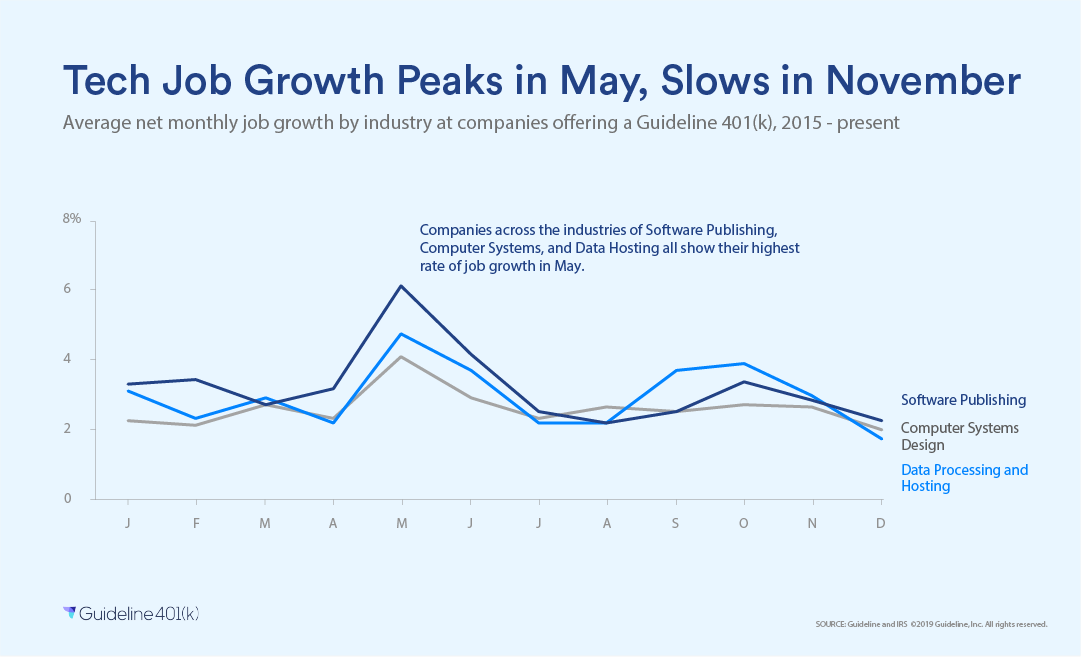
Seasonality & hiring: technology
Read part 1 of our report on accounting, law, finance, and healthcare industries.
Read part 3 of our report on the retail industry.
Across technology-centric industries, small business job growth follows a similar pattern of seasonality with the strongest job growth of the year happening in May, according to new data from Guideline.
This is the second of three posts looking at seasonality in small business job growth, based on our analysis of monthly employment from 2015 through the present at companies offering a Guideline 401(k). The first post explored what seasonality means and focused on the accounting, law, finance, and healthcare industries; and the third post focuses on retail and leisure.

Software Publishing, Computer Systems Design, and Data Processing and Hosting all show a very similar pattern of seasonality, with companies increasing the number of jobs by 4-6% on average in May, making this the strongest month in the year for job growth in this sector. After a summer dip, job growth rises again in the fall, with growth of around 3% in October. The winter and spring again see slightly lower--but still very strong overall--job growth, with rates ranging from an increase of just under 2% to just over 3% in the number of jobs each month.
What’s the takeaway for small businesses and job seekers?
If your small business or startup in the tech industry is looking for new employees, your best bet is to share a link to your job ad on LinkedIn and Twitter, attend networking events, and write those Medium posts whenever you’re ready to hire.
But, by understanding these patterns of seasonality in your industry, you can adjust your expectations: in the spring and fall, when more hiring takes place, you may receive a higher number of applications and have to compete with more companies when making offers to top candidates. In the summer and winter, when less hiring takes place, you may need to spend more time searching for candidates--but the upside is that once you find a fit, there may be fewer companies making competing offers.
If you’re looking for a job in a tech startup or other small business in the industry, know that job growth at companies offering Guideline 401(k)s is robust year-round, relative to job growth in the economy as a whole, so get in the game whenever it’s best for you. Just know that in the spring and fall, you may compete with more candidates for a larger number of available roles; and in the winter and summer, there may be fewer openings, but also less competition.
Are you looking for an easy, low-cost 401(k) plan for your small business? You can get started with Guideline at www.guideline.com, or email us at hello@guideline.com to get answers from a specialist.
Methodology
We analyzed anonymized employment data from over 9,000 companies that offer Guideline 401(k) plans. Our analysis counted job gains based on payroll data from company expansions and job losses from company contractions, but not gains and losses due to companies being founded or going out of business.
Companies were classified into industries based on the North American Industry Classification System (NAICS) code each company selected in their Form 5500 publicly filed with the Internal Revenue Service (IRS).
The Software Publishing industry includes many companies commonly referred to as being in the technology sector, including not only traditional software vendors but also software as a service (SaaS) companies that offer applications over the internet.
Data Processing, Hosting, and Related Services refers to companies that offer physical computing infrastructure as well as those that offer services based in the hosting and processing of data, such as data entry, media streaming, image analytics, and web hosting. The professional services industry of Computer Systems Design includes companies that offer expertise or services in software, hardware, or other computer-related areas.
A note on the differences in the number of working days in each month, after weekends, holidays, and the length of each month are considered: May and October, the months with the strongest job growth rates in the industries considered here, also have more working days--in 2019, each had 23 working days, versus 20 in February and June.
That said, with 15% more working days and about twice the rate of job growth as in the slowest months, the number of working days in each month accounts for only a fraction of the seasonal variation.
Media requests, questions, and comments about this data can be sent to data.research@guideline.com.


